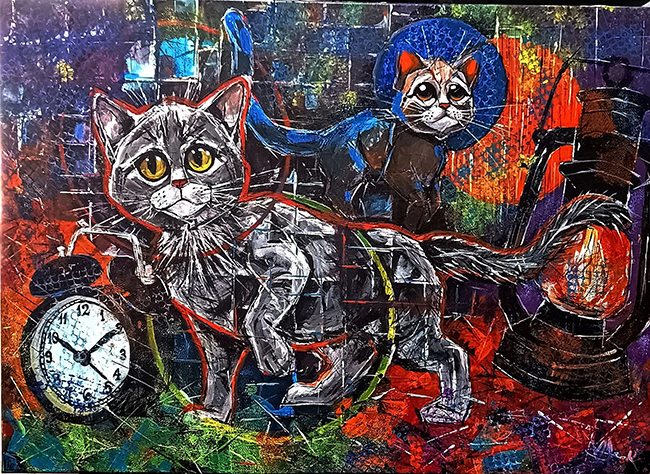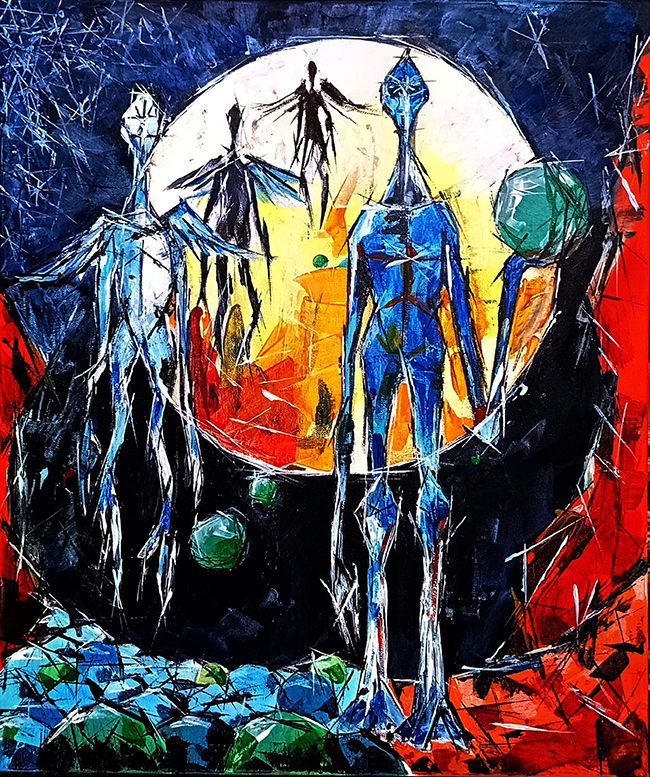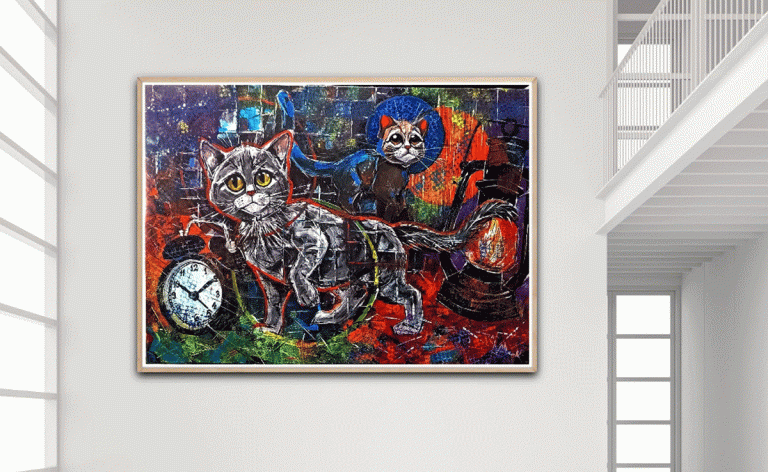Albert Deak’s art invites exploration—it opens doors to unfamiliar spaces and layered ideas. Since earning his degree in ceramics from a respected university in Eastern Europe in 1989, Deak has followed an ever-expanding creative path. He began with clay, a material rooted in form and touch, then moved into painting, graphics, and digital work. With each transition, he’s deepened his focus on ideas rather than tools, using every medium as a way to engage with concepts that stretch beyond the visible and the known.
Deak draws on the freedom of Pollock, the layered ambiguity of Richter, and the spiritual focus of Kandinsky—but he doesn’t imitate. He builds something distinct from those roots. His work pulls from science, emotion, metaphysics, and inner space. Abstraction is his tool, but not his hiding place. Rather than clarity, he offers presence—works that ask you to feel, to pause, to rethink how you interpret the world around and within you.

The Enigma of the Cat and the Clock of Existence
This painting sits in a zone of strange familiarity. A cat, a clock, and a lantern. These could be cozy symbols in another setting, but Deak turns them into something uncertain, even unsettling. The inspiration comes from quantum superposition—the idea that things exist in many states at once, waiting to collapse into one reality only when observed.
Here, Deak pulls that idea into art. The cat isn’t just a symbol; it’s a reference to Schrödinger, observation, and possibility. The clock is time, but not time you can trust. The lantern might be showing you something, or nothing at all. Everything in the piece hovers in potential.
Deak doesn’t spell out the meaning. He invites you to linger in the ambiguity. He forces you into the role of the observer, asking what changes when you look. The brushwork is loose, but not careless. It’s expressive, yet deliberate, circling around a set of ideas that don’t quite land—because they’re not supposed to.

The Two Universes and Their Inner Music
This one pulses. It has movement, even sound, even if the sound is imagined. It’s full of color, swooping lines, layered light. At the center is a violin. Beside it, a glowing human shape. These symbols aren’t presented with precision, but they carry weight. The violin brings music and emotion. The figure suggests awareness, maybe consciousness itself.
The title gestures toward something huge: multiple universes and the idea that each carries a kind of rhythm. For Deak, this rhythm seems less about literal sound and more about hidden resonance. The way galaxies spin, or how thoughts ripple through memory.
Chaos sits next to calm here. Curves and straight edges talk across the surface. Colors clash and settle. The painting is less a visual message and more a vibration. You don’t decode it. You tune into it. The harmony comes not from tidiness but from contrast—the sense that everything here belongs even when it doesn’t match.

Travels From Other Worlds
This piece feels like the heart of Deak’s current direction. It’s anchored by a translucent central figure that feels both present and otherworldly. The figure isn’t standing tall in control—it’s mid-motion, mid-thought, holding a green globe. Maybe it’s Earth. Maybe something more symbolic: life, responsibility, a seed of potential.
Other forms move upward around it. Not quite angels, not quite spirits, but extensions—like thoughts that have taken shape and drifted free. There’s a spiritual sense here, but not one tied to any specific belief. It’s more about transformation. Becoming. Letting go.
The colors in the background pulse like light, not just suggesting energy but almost being it. They surround the figure without swallowing it. The whole piece feels balanced between surrender and purpose. It’s not a call to action. It’s a quiet moment of awareness, framed in visual metaphor.
Final Thoughts
Albert Deak isn’t making art to impress or shock. He’s charting something internal—how it feels to question, to observe, to drift between known and unknown. His work is rooted in both emotion and thought. It borrows freely from science, philosophy, and memory, but always with a personal undercurrent.
What makes his paintings compelling isn’t technical polish or grand statements. It’s the honesty behind them. They don’t try to resolve anything. They’re about lingering in the open space—where meaning might form or dissolve, depending on how long you’re willing to look.
Every piece is a pause. A thought in motion. A place where art isn’t about answers, but the strange comfort of not needing one.

